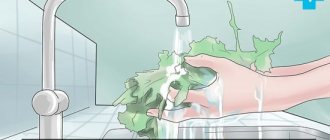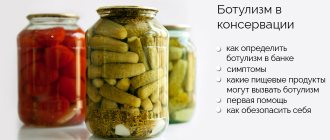Clostridium botulinum is a bacteria that causes the serious infectious disease botulism. They multiply in an airless environment and secrete a substance called botulinum toxin, which damages nerve tissue. Botulinum toxin enters the human body with food and causes life-threatening disorders. Therefore, first aid and medical care for botulism should be provided as early as possible.
Gastric lavage
The standards of first aid for botulism poisoning at the prehospital stage include the release of the digestive organs from toxin residues: gastric lavage and cleansing enema.
For washing use:
- 5% soda solution;
- tannin;
- weak solution of potassium permanganate.
The procedure is carried out with a thick probe inserted directly into the stomach. Afterwards, sorbents are prescribed internally: coal, Enterosgel to bind botulinum toxin.
Under no circumstances should you wash the stomach of an unconscious patient!
Forced diuresis
It is one of the ways to quickly rid the body of toxins by removing them through the kidneys. To stimulate diuresis use:
- hypertonic 40% glucose solution,
- Mannitol,
- Furosemide.
Let's summarize. Botulism is a rare disease, but very dangerous. Sometimes the development of complications occurs rapidly, so before hospitalizing the patient in the infectious diseases department, you need to not get confused and use all possible methods to provide him with first aid.
Purgation
At this stage you can choose from two options:
- give the patient a saline laxative and wait for spontaneous bowel movements (for example, 30 g of magnesium sulfate);
- do a high siphon enema with boiled water.
The listed procedures for cleansing the stomach and intestines should never be neglected. This is the very first aid for botulism and is very effective. These measures will significantly improve the patient’s well-being and stop the flow of botulinum toxin into the blood.
Additional cleaning procedures
To bring the lavage measures to their logical conclusion, the patient needs to additionally cleanse the intestines.
This can be done in two ways, depending on the availability of appropriate medications or related equipment. Methods include:
- dispensing saline laxatives;
- performing a siphon enema based on boiled water for safety.
In the first case, it is necessary to wait until the drug takes effect so that the person feels the characteristic urge to go to the toilet and is able to cope with bowel cleansing himself.
Despite the standards of the measures described above, some people neglect this, believing that home help is ineffective. In turn, experienced doctors claim that correctly provided first aid for botulism at home is often the key to successful recovery in the future.
This range of measures is aimed at sharply limiting the flow of microorganism poisons into the bloodstream and further into the organs.
Cardiopulmonary resuscitation (CPR)
If the patient's condition worsens, paralysis of the respiratory muscles and breathing stops, it is necessary to immediately (before the ambulance arrives) begin artificial ventilation of the lungs and chest compressions. This is emergency care for botulism.
If there is a pulse in the carotid artery and there is no breathing, only ventilation is performed using the “mouth to mouth” or “mouth to nose” method, blowing air into the patient’s lungs approximately once every 5 seconds. You must first prepare and clear the airways of saliva, vomit, and foreign objects (if any).
If breathing and heartbeat stop, cardiopulmonary resuscitation is performed. Sometimes it is possible to restore heart function by performing a precordial blow to the chest. The disadvantage of this method is the possible fracture of the ribs.
The CPR procedure is performed 1:5 (one blow every 5 chest compressions) when assisted by two people and 2:15 when assisted by one. The effectiveness of resuscitation can be judged by the appearance of spontaneous breathing and pulse.
Main clinical symptoms
Incubation period from several hours to 2-5 days
- Symptoms of general intoxication, hyperthermia is possible on the first day of the disease;
- Gastrointestinal syndrome (nausea, vomiting, possible one or two loose stools in the initial period, then flatulence followed by constipation);
- Paralytic syndrome (damage to the nerve structures that provide the mediator process in the synaptic links of the motor sphere).
The severity of botulism according to the severity of paralytic syndrome
Mild form of botulism:
- Ophthalmoplegic syndrome (visual impairment: blurred vision, diplopia, mydriasis, possible anisocoria, limited mobility of the eyeballs, weakened or absent reaction of the pupils to light, ptosis);
- Mild muscle weakness.
Moderate form:
- Ophthalmoplegic syndrome;
- Bulbar syndrome (dysphagia, aphonia, nasolalia, dysarthria);
- Paresis and paralysis of facial and masticatory muscles are possible;
- Severe muscle weakness during physical activity;
- disorders of external respiration function.
Severe form:
- Severe ophthalmoplegic syndrome;
- Severe bulbar syndrome;
- Symmetrical descending paralysis;
- Impaired external respiration function (damage to the intercostal muscles and diaphragm), up to respiratory arrest;
- Flatulence, bladder paresis;
- Arterial hypotension.
Antibotulinum serum
Serum against botulism comes in three types: A, B and E. There is also a polyvalent serum containing immunoglobulins of all serotypes of the bacterium.
As a rule, when signs of botulism appear, the last or 3 drugs (A, B and E) are administered simultaneously, and when the type of infection is clarified, treatment is continued with a certain type of monovalent serum.
Antibotulinum serum is a solution of specific protective immunoglobulins (Jg) from the blood of a horse infected with botulinum toxin. The drug is extremely allergic, so a sensitivity test is required.
A serum diluted 1:100 in an amount of 0.1 milliliter is injected subcutaneously into the elbow area and the reaction is observed. If swelling and redness of more than 1 centimeter appears after 20 minutes, the test is considered positive. However, such a result is not a contraindication to intravenous administration of the drug. An ampoule of whole serum is diluted in 200 ml of sodium chloride solution and injected into a vein by drip. If the skin test is positive, before treatment the hormone prednisolone 60–90 mg is prescribed intravenously in a bolus to reduce the risk of allergies.
The only contraindication to the use of anti-botulinum serum is a severe allergic reaction to an intradermal test in the form of anaphylaxis!
It is important to note that the earlier you start treatment with serum, the more effective its effect will be. All treatment activities are carried out in a medical office equipped with an anti-shock kit. During the procedure, the doctor carefully monitors the patient's condition.
Diagnosis of botulism
The diagnosis is based on the clinical picture, laboratory and biological studies. In addition to basic studies: blood analysis, urine analysis and blood biochemistry, biological tests and bacteriological studies are carried out.
Bacteriological test. To diagnose botulism, take 4 white mice or guinea pigs. Two of them are injected with the patient's blood, the other two are injected with the patient's blood along with antibotulinum serums. If animals injected with blood die, the diagnosis of botulism is confirmed. To treat the patient, use the serum that was administered to the surviving animal.
Bacteriological research method. For analysis take:
- vomiting
- gastric lavage water,
- leftover food (canned food, fish).
All material is sown on Kitta-Tarozzi nutrient medium or pepsin-peptone. In order for colonies to begin to grow, it is necessary to create anaerobic conditions (without oxygen).
IMPORTANT! Collection of material for bacteriological examination must be carried out before the administration of antibotulinum serum. Products must be collected in sterile containers.
General clinical blood tests may not be changed. The ESR rate increases, and slight leukocytosis occurs. During a biochemical study, a decrease in the amount of microelements (calcium, sodium, potassium) occurs. Creatinine may increase.
Parenteral detoxification
This term refers to the intravenous and intramuscular administration of drugs, the action of which is aimed at binding, neutralizing and removing the toxin, as well as correcting the resulting disorders of organs and systems.
Detoxification can be carried out both at the pre-hospital stage - by emergency medical services doctors with the necessary equipment of the team with all medications, and in the hospital.
- Hemodez N, Reopoliglyukin, Gelatinol, Neocompensan and other solutions are administered dropwise according to indications. The choice of drug and dose is determined by the attending physician based on the severity of the individual patient’s condition. The listed solutions improve microcirculation, saturate tissues and cells with oxygen and glucose, normalize water and electrolyte balance, improve blood metabolism and fluidity, neutralize and remove poisons and toxins.
- To provide cells with energy and normalize the functioning of the cardiovascular system, glucose-potassium-magnesium mixtures, Riboxin, Mildronate are prescribed.
- In case of hypotension, Cordiamin 1 ml is injected subcutaneously, to stimulate breathing (especially with developed paresis of the intercostal and diaphragmatic muscles) Strychnine, Corazol 1 ml of 10% solution or Lobelin.
- To replenish the water balance (fluid loss through vomiting, urine and intestinal contents), isotonic sodium chloride solution and glucose are infused intravenously.
Sequence of manifestation of symptoms of the lesion
Symptoms of the disease begin to make themselves felt in the following order:
- Nausea with vomiting and diarrhea
- Constipation, which is followed by acute forms of gastroenteritis.
- Ophthalmological signs - diplopia, double images, unexpected horizontal or vertical nystagmus.
- Dysphonia, nasal voice.
- Sudden manifestation of an acute form of respiratory failure: rapid breathing, fogging of the skin, fear, search for a comfortable body position in order to involve auxiliary muscles in the respiratory act.
Emergency actions in a medical facility
Prehospital emergency care for botulism in a medical facility consists of gastric lavage. For this, 2 methods are used:
- Thick probe. It is a rubber tube 1 cm thick and 120 cm long. It is inserted through the oral cavity into the stomach. A pump is placed on the free part of the tube and liquid is poured through the funnel. 5-6 milliliters of liquid are injected per 1 kg of patient weight. The device is held while injecting liquid just above the patient's head. As soon as the poured water reaches the mouth of the funnel, it is lowered below chest level so that the liquid can flow out. The procedure is carried out until the water becomes clear.
- Thin probe. Used for childhood poisoning or in case of impaired swallowing reflex. There are 2 types of thin probe - for rinsing through the mouth and through the nose. A Janet syringe is used to administer the solution. A single dose of liquid for rinsing for babies from 1 year old is 200 ml, up to a year old – 100 ml. A single dose of solution is drawn into a syringe and injected into the stomach. The piston then pulls towards itself, sucking out the wash water.
When intestinal paresis is observed, siphon enemas are performed. The procedure is intended to stimulate the atonic intestine. The tube is inserted to a depth of 20-25 cm and a solution is poured in small portions, the total volume of which is 10-15 liters. Proserin is used, a substance that restores neuromuscular activity, which is impaired during botulism.
To effectively eliminate botulism, emergency treatment must include the administration of antitoxic serum. There are several types of botulinum toxin, the serum is selected individually for each type (A, B, C, D), neutralizing the toxin. When the type of pathogen is unknown, polyvalent serums are prescribed. The drug is administered intramuscularly or intravenously. The dosage is selected individually, depending on the severity of intoxication.
Causes of the disease
Infection occurs when eating food containing botulinum toxins. In rare cases, the development of wound forms of the disease associated with the ingress of botulinum toxins and bacteria onto the wound surface is noted.
Despite the fact that in the intestines of many animals there are spores of clostridium botulism, it is also impossible to become infected from animals.
From the gastrointestinal tract, spores are actively released into the environment and remain in the soil for a long time. However, when eating unwashed fruits or vegetables, botulism also does not develop (an acute intestinal infection may occur). This is due to the fact that botulism is caused by botulinum toxin produced by vegetative forms of clostridia, and the spores themselves are not capable of producing toxins.
For the spore form to transform into a toxin-producing form, oxygen-free conditions are required, which are created during the production of homemade pickles, preserves, marinades, etc.
How to destroy the causative agent of botulism
It is impossible to destroy spores in home production conditions. They die only during the industrial production of preserves, using high temperatures and pressure.
Homemade products can be completely protected through high-quality heat treatment. Botulism toxins have a polypeptide structure and are completely destroyed when treated for 30 minutes at temperatures above 80 degrees. When stewing foods for preservation, they should be thoroughly mixed to prevent insufficient temperature treatment of individual pieces of food.
When boiling, vegetative forms and toxins are neutralized within 10-15 minutes. It should be noted that spore forms of bacteria are preserved in the product during such processing, therefore, with each subsequent use of an already opened canned food, it must be thermally treated again.
How to recognize botulism
It is impossible to recognize food containing toxins by taste, color or smell. Botulinum toxins do not change the taste of the product at all and are odorless. In isolated cases, canned food containing toxins and vegetative forms of botulism may emit a faint smell of rancid oil.
A distinctive feature of botulinum toxin is also its widespread distribution in solid products. That is, if several people consumed the same product, only the one who ate the piece containing toxins and vegetative forms will get sick. Other people who consumed the same product may remain completely healthy, or, if they consume a small amount of the toxin, experience a milder form of the disease.
Supportive treatment in hospital settings
After emergency treatment methods have been carried out, a period of parenteral detoxification begins. Its main task is the administration of drugs that bind, neutralize and remove toxins. In addition, such therapy allows you to smoothly get rid of the consequences for organs and tissues that arose during the poisoning process.
Doctors also often resort to forced diuresis. This allows you to speed up the process of freeing the body from accumulated poisons, which are released through processing by the kidneys.
Remember that the sooner the patient is transferred to the hands of medical workers, the higher the chances of his speedy recovery.
Botulism is an acute food intoxication that develops due to botulinum toxin entering the body. Ingested by eating food containing spores. May lead to cardiac arrhythmias and respiratory failure. If symptoms of poisoning appear, first aid for botulism should be provided promptly.









